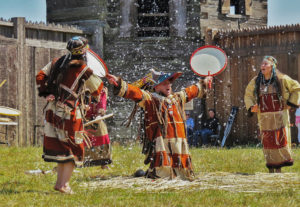San Francisco’s Presidio is among the richest historical sites in the Bay region, or perhaps in all of California, a place with structures and changes in the landscape that go back to the arrival of the Spanish in 1776 and to the centuries before that when the Ohlone created settlements near the park’s streams and springs.
In our April 2007 feature Whispers in the Water, we just scratched the surface of the life of longtime Presidio resident Juana Briones, a true pioneer who forged her own path, establishing, with her two sisters, a commercial empire that included thriving businesses and real estate in several Bay Area towns.
Juana and her sisters, who all lived near El Polin Springs at some point, developed a prosperous business marketing fresh milk, meat, and vegetables from their farms to sailors and merchants on visiting ships. The Tennessee Hollow Watershed Archaeology Project, a joint research project of Stanford University, the Presidio Trust, and the National Park Service, continues to unearth clues as to how this valley was used by Juana and her contemporaries during the Spanish-colonial and the Mexican periods of the Presidio. In 2003, archaeologists discovered artifacts and the stone foundation of a Spanish-colonial/Mexican period adobe house where the Briones family likely lived.
Juana Briones’s legacy extends well beyond the Presidio. With the profits from her business, Juana purchased the 4,400-acre Rancho Purísima Concepcion, located in the hills of present-day Palo Alto and Los Altos Hills. A part of her adobe home still stands on Old Adobe Road in the Los Altos Hills. The 160-year-old home has been the subject of a nine-year legal battle between the current landowners and city officials and preservation groups who have been fighting to preserve the building, which was seriously damaged in the 1989 Loma Prieta earthquake. The owners have said that the $800,000 to $1.5 million required to repair the building is prohibitively expensive. The city of Palo Alto agreed and recently issued a demolition permit for the site. The owners have agreed to allow the Juana Briones Heritage Foundation to have the property photographed and surveyed before demolition. Read the San Francisco Chronicle article PALO ALTO: 160-year-old home can be demolished.
Unearthing Juana Briones’s connection to El Polin springs provides one of many pieces of a puzzle the Presidio Trust is putting together to inform restoration of the Tennessee Hollow Watershed. Because of its importance to Spanish colonial settlement and the prominent role it has played in U.S. Army history, the Presidio, in its entirety, was declared a National Historic Landmark District in 1962. Read more about the Presidio’s remarkable history online.
Many Presidio preservation projects are either underway or have been proposed. Among the largest of the projects is the reconstruction of Doyle Drive, a critical section of Route 101 that connects San Francisco to the Golden Gate Bridge along the Presidio’s northern waterfront. The project recently received significant state funding, and will of course have major implications for Marin County commuters. But it will also likely open the way for connecting upstream sections of the Tennessee Hollow Watershed with Crissy Field Marsh. For details regarding this huge undertaking and opportunities for public comment, go to the project website.
Descriptions of other major park projects can be found on the Presidio Trust’s website.
The Presidio Trust’s website also provides information on a number of ways you can get involved by volunteering for projects such as the Presidio Native Plant Nursery or the Presidio Archaeology Lab. Details about these and other opportunities can be found at the volunteer page.

.jpg)



